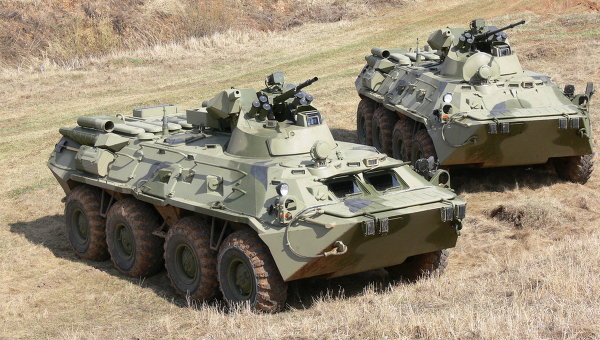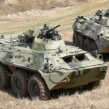
Putin Blasts Rogozin Over Rearmament Failures
Publication: Eurasia Daily Monitor Volume: 10 Issue: 145
By:

Moscow’s highly ambitious military rearmament plans to 2020 always appeared destined to encounter major setbacks linked to the capacity of the domestic defense industry to deliver the modernization of weapons and equipment for the Armed Forces. However, on July 31, within a few days of the conclusion of large-scale military exercises in the Russian Far East, President Vladimir Putin publicly rebuked Deputy Prime Minister Dmitry Rogozin over the failures of military production. Rogozin as the Chairman of the Military Industrial Commission was likely to be in the firing line with every “discovery” of such failings, but Putin has taken the unusual step of highlighting this in public. Putin blamed Rogozin for not taking personal control over a large number of issues linked to the defense industry as well as for slow progress in this area. He invited him to “draw conclusions,” otherwise the Kremlin would draw its own conclusions with regard to military production (Ekho Moskvy, July 31).
Numerous equipment failures were certainly reported in the aftermath of the first “snap inspection” exercise in February 2013, and additional insight into the grossly inadequate condition of military infrastructure was exposed by the inspection exercise in the East Military District (MD) in July. Defense Minister Army-General Sergei Shoigu complained more generally about communications issues, referring to only “18-percent” advances in relation to the modernization of “command, control and communications” (C3). Additional problems, such as the relatively small number of vehicle breakdowns or, more importantly, the very quantity of modern weapons and equipment in East MD, could also have prompted fresh questions about the rate of modernization in the Armed Forces. Reportedly, East MD only possesses approximately 17 percent new military vehicles (Interfax, August 4; https://nvo.ng.ru/forces/2013-08-02/1_task.html).
An additional and perhaps more politically sensitive issue for the commander-in-chief (CINC) appears to be the modernization of the Russian Navy. Putin laid great emphasis on rebuilding the Navy in his pre-election article in Rossiyskaya Gazeta in February 2012 and has long fostered a pro-naval side to his public relations image making (https://rg.ru/2012/02/20/putin-armiya.html). Putin has finally admitted, however, that the naval rearmament component in the State Armaments Program (Gosudarstvennaya Programma Vooruzheniya—GPV) 2011–2020 may not be fulfilled. On July 29, RIA Novosti reported that the CINC recognizes that construction of warships earmarked for the current GPV may need to be postponed until 2025. The construction work, according to Putin, needs to be structured in such a way as to guarantee that it matches the money invested by the State; if there is no progress toward an acceleration of shipbuilding activity, then the allocated funds must be frozen (https://ria.ru/defense_safety/20130729/952767344.html#ixzz2ahuDUHTe).
There is certainly no shortage of complaints about the prospects for naval modernization, with former naval commanders offering details on the glacial rate of progress—if any is actually occurring (https://ria.ru/interview/20130728/952342132.html). Although these issues are clearly becoming a headache for Putin, the wider modernization program causes concern. The numerous organic problems underlying the limited capacity of the defense industry are well known, ranging from a shortage of skilled workers, to corruption and price transparency issues. Another factor is linked to quality control, and here Putin has to witness the present defense minister unpicking serious errors committed by his predecessor, Anatoly Serdyukov, in 2008–2012; the most significant of these is the reintroduction of military representatives in the defense ministry removed by Serdyukov from involvement in the process of determining the quality and prices of military products (https://www.vpk-news.ru/articles/16799).
Defense ministry data suggests that the military representatives return up to 90 percent of items to the defense industry due to failing at testing stages; the number of complaints linked to this is growing. In 2012 complaints grew by 60 percent year-on-year: in 2011, there were 1,918 complaints submitted. Some of the reasons for this state of affairs, and the apparent increase in complaints about military products at the testing stage stem from the growing numbers of equipment and weapons items still under warranty, the intensity of military exercises and the arrival of “under-developed” models in the Armed Forces. The level of on-site management of quality management systems at a number of defense manufacturers also declined during the 2000s; civilian involvement, for instance, was practically eliminated (https://www.vpk-news.ru/articles/16799).
Such systemic failures were linked to 76 defense contracts in the period 2008–2012 remaining unfulfilled, and in 2012 more than 20 percent of weapons and military equipment products were classed as “under-supplied.” Colonel Oleg Stepanov, the chief of the Military Representations Administration in the Ministry of Defense, believes that major defense companies are disrupting the state defense order (Gosudarstvennyi Oboronnyi Zakaz—GOZ); these include the companies manufacturing BTR-82A armored troop transports as well as producers of An-140 aircraft, anti-tank missiles, and the S-400 air defense system. Moreover, the problems also extend into equipment servicing, which is very serious as this will mitigate the military’s capability to deploy and sustain operations. In the first six months of 2013, no more than between 15 percent to 20 percent of equipment scheduled for servicing was actually serviced, no doubt linked to the ongoing problems associated with Oboronservis (https://www.vpk-news.ru/articles/16799).
On March 24, 2013, Shoigu effectively ordered the undoing of Serdyukov’s actions against the Military Representations Administration in order to facilitate better quality control and pricing on defense products. Though this will take time to both fully restore and improve. The capacity of the defense industry remains weak, and the capability of the defense ministry to impose regulation and improve standards cannot offer a single and simple solution. Without significant progress, Rogozin could be blamed in the future for multiple setbacks and politically sacrificed, as Putin steps back from the disastrous effort to achieve impossible military modernization targets (Ekho Moskvy, July 31; https://ria.ru/defense_safety/20130729/952767344.html#ixzz2ahuDUHTe).
The sources of Putin’s anxiety over the future of the GPV to 2020 and the annual GOZ are therefore multiple, though other actors within the political system may not appreciate either his interest or his apparent realism. Behind the public smokescreen of the military exercise in East MD, the CINC may be gaining new insights into the extent of the mess in the Armed Forces bequeathed by Serdyukov. Russia’s defense production capacity is open to question, especially its potential to manufacture sophisticated electronics to support Moscow’s drive to adopt “command, control, communications, computer, intelligence, surveillance and reconnaissance” (C4ISR) capabilities, and this presents a predicament for officials trying to square the circle of force transformation to a suspect modernization agenda.




